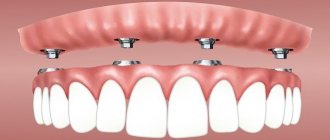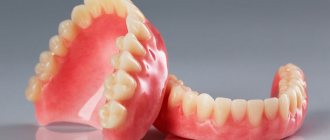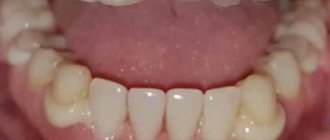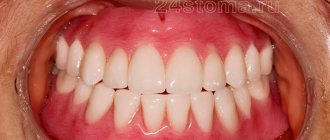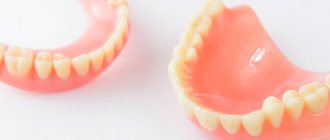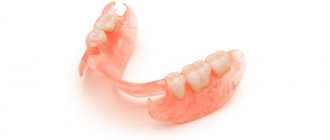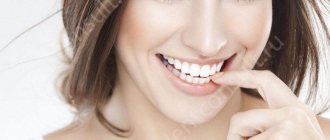From this article you will learn:
- cost of prosthetics,
- pros and cons of QuattroTi dentures,
- how comfortable it is to chew with them – patient reviews.
Quadrotti dentures (QuattroTi) are often called clasp dentures of a new generation, in which the arch and support-retaining clasps will no longer be made of metal, but of a very durable and aesthetic polymer material “Dental-D”. The latter is a monomer-free plastic based on polyoxymethylene, the strength of which is 15 times higher - compared to the strength of dentures made from conventional acrylic plastic.
It is due to their high strength that QuattroTi prostheses are compared to clasp prostheses, although in fact they are much closer to nylon prostheses. Like the latter, they also have a little flexibility (but it is less than that of nylon dentures), and also have highly aesthetic clasps, invisible against the background of the patient’s own teeth. In addition, Quadrotti dentures are lightweight, have a reduced base size compared to removable dentures made of acrylic plastic, and have a long service life of at least 7 years.
What do Quadrotti prostheses look like?
Patient reviews of Quadrotti dentures are quite contradictory. For example, patients certainly note their good aesthetics and inconspicuousness in the oral cavity, low weight, as well as quick adaptation to the prosthesis. However, on the other hand, many patients note pain when chewing solid food, and, in comparison with clasp dentures, slightly worse fixation on the supporting teeth. And below we will tell you what this is connected with.
Manufacturer information
The Vertex-Dental company was formed on the basis of the Dentimex company (opened in the Netherlands in 1939). The name “Vertex” itself is translated from Latin as “crown” or “highest point of something”, i.e. With just its name, the manufacturer seems to indicate that its products are of the highest quality. In the course of its development over almost 100 years of history, the company has gone from a local manufacturer of acrylic prostheses (which at that time became an excellent replacement for rubber products) to a large concern that produces plastics and production lines for most types of prostheses known today.
Today, Vertex products are supplied to 75 countries around the world and, as the manufacturer himself notes, about 100 thousand dental technicians use them daily. For about 25 years, we have had our own training department, the Vertex-Dental Academy.
Types of Vertex materials
The most popular material from Vertex-Dental, which has been talked about lately, is the “hero” of today’s article - thermoplastic based on Vertex ThermoSens polyamide (modern nylon). Its features will be discussed further below. In the meantime, let’s touch a little on other materials from the company, such as:
- acrylic: available in two modifications - heat-curing Rapid Simplified (cadmium-free) and cold-curing Castvaria (for finishing, repair and relining),
- artificial acrylic teeth – Vertex Quint teeth: durable teeth made from 5 layers of innovative materials have a natural appearance and long service life. More than 16 shades of artificial teeth are offered for people of any age and race. Suitable for fixing on acrylic bases,
- liquid preparations for the manufacture of prosthetic structures,
- tools for manual and machine processing of products,
- devices for the full production cycle: pressing, polymerization, casting, etc.
PROSTHETICS WITH 6 OSSTEM IMPLANTS FROM RUB 200,000.
Complex implantation Osstem (South Korea) with delayed loading after 4-6 months.
Call now or request a call
Features and key advantages of Vertex Thermosens
Vertex ThermoSens thermoplastic is supplied in the form of small beads. Their color can range from transparent or white to rich pink - a total of 12 shades are produced. According to numerous positive reviews from practicing orthopedic dentists, dental technicians, as well as patients themselves, the Vertex Thermosens denture material has the following advantages:
- strength and durability: according to the manufacturer, the material is stronger than similar plastics - therefore thinner structures can be made from it. And Vertex ThermoSens “knows how” to efficiently collect excess load, reducing the risk of chips and cracks when the structure falls on the floor, for example, or when used carelessly,
- high density of the material: therefore it is minimally colored with food dyes, tobacco,
- small mass,
- high aesthetics that perfectly matches the color of the patient’s gums: the dye is not added at the end of production, but is introduced into each thermoplastic ball during mixing at the factory. Therefore, during the manufacture of the structure in the laboratory, unpleasant “surprises” are excluded, for example, poor painting, streaks or stains, unnatural shades,
- ease of polishing the material at the final stage of manufacturing,
- biocompatibility: the material contains no allergens (unless, of course, the design is supplemented with acrylic inserts), so it is suitable for allergy sufferers and people with hypersensitivity,
- minimal shrinkage over time: for Vertex ThermoSens material shrinkage is less than 1%, so the prosthesis is very precisely fixed in the oral cavity.
Vertex dentures: advantages and features
The main feature of the Vertex prosthesis is the use of semi-rigid thermoplastic in the manufacture. It distributes pressure on the gums better and does not deform when drinking hot drinks. Among the advantages of denture construction:
- hypoallergenic;
- does not add any foreign taste to food;
- easy to care for;
- does not worsen the condition of the gums.
If you analyze the information, Vertex dentures have many reviews for and against. But the opinion of dentists is decisive. They consider plastic structures from a Dutch manufacturer to be the best in the ratio “affordable price - excellent quality.”
Read Dentures with suction cups - how to use them, storage and care of such dentures
What are the disadvantages of the material?
The disadvantages of Vertex ThermoSens are difficult to include such disadvantages of nylon as excessive flexibility or rapid darkening from food coloring. But if inaccuracies were made at the manufacturing stage of the orthopedic structure, then these shortcomings may well appear. And the prosthesis will quickly stretch or darken (and it will not be possible to bleach it). Similar defects can occur if a person likes to simultaneously eat food at different temperatures - drink ice cream with coffee, for example, or drinks a lot of red juices, wine, or smokes a lot.
Repairing such a structure is also not always possible - if there is some kind of extensive damage or a large crack, a massive build-up of material will be necessary (during relocation). And minor repairs, for example, gluing a lost tooth, building up a broken hook (clasp), can be done.
For which prostheses is Vertex ThermoSens suitable?
Dentures made from Vertex ThermoSens material are placed on any jaw – upper and lower. Designs can vary in length and method of attachment in the oral cavity. This can be a complete removable denture for the entire row with a complete absence of teeth, a partial one, as well as a “butterfly” - replaces 1-2 missing teeth. In these cases, the prosthesis is attached to the gums - due to the “suction cup” effect, and to the remaining teeth - using small hooks or telescopic crowns made of the same material. Full removable ones have a massive palate on the upper jaw, and a voluminous artificial gum on the lower jaw. Also, removable dentures on implants can be made from the Vertex material - the method is suitable for patients with complete or almost complete absence of teeth.
Interesting to know! Another type of orthopedic structures made from the Vertex material are dental splints. This product is suitable, for example, for patients with bruxism (teeth grinding).
Akri free dentures: reviews from dentists
The plastic from which this type of prosthesis is made belongs to the class of thermoplastics. Thanks to this, for example, the use of a toxic monomer, to which patients are often allergic, is not required. Before the advent of the Perflex® Acry-free material, patients with an allergy to the acrylic plastic monomer could only be offered nylon prostheses, which had many disadvantages.
Secondly , the production of this type of prosthesis occurs using injection molding (at high temperatures), which makes it possible to achieve a very precise match between the surface of the prosthesis and the shape of the prosthetic bed. As a result, the denture is more stable, comfortable to wear and chew food, and rubs the gums less, but only when compared with dentures made of nylon (which are almost impossible to chew without pain).
Thirdly , an acrifri prosthesis has a thinner plastic base compared to prostheses made of conventional plastic (i.e., it occupies less volume in the oral cavity). It also has significantly less weight, which is especially important for better fixation of the prosthesis on the upper jaw. Ask your dentist to let you hold a regular acrylic denture and Acri free dentures in your hands - and everything will immediately become clear to you.
Acry-free®: video of prostheses and manufacturing stages
Additional benefits –
- Moderate flexibility - this type of prosthesis is characterized by moderate elasticity, which creates comfort for wearing (however, it is not excessive, like with nylon prostheses). It should be noted that the high elasticity of nylon dentures leads to rapid atrophy of the bone under the denture and painful chewing of food. In addition, dentures that are too flexible have the problem of food particles getting under the denture (which Acry-free does not have).
- Hypoallergenic – Perflex® Acry-free plastic is thermoplastic and therefore does not contain the toxic monomer to which allergies often occur.
In addition, if you want to make the prosthesis completely hypoallergenic, then in the manufacture of the prosthesis you should use dental sets made of ceramics and not plastic (but this will greatly increase the cost). As a dentist, and in fairness, I note that in 90% of cases, an allergy to the monomer in acrylic dentures does not develop due to the patient and his body. It’s just that most dental technicians, when mixing acrylic plastic, do not accurately measure the ratio of monomer to acrylic, but pour the monomer into the eye, which causes an “allergie” (although this is essentially a toxic reaction). In most cases, after alteration of the prosthesis from acrylic plastic, the allergy miraculously disappears.
- Good aesthetics – acry-free plastic comes in a variety of shades and translucencies, and you will choose these characteristics with your doctor during your consultation. This achieves a natural appearance of the prosthesis, which is almost invisible in the mouth, which makes acry-free dentures similar to nylon ones in terms of aesthetics (24stoma.ru).
A very important point is that the clasps of the Acry-free partial denture are not made of metal, but also of elastic pink plastic, which makes this denture more invisible (Fig. 5). In addition, if you have a good budget and high aesthetic requirements, dental sets made of ceramics rather than plastic can be used to make a prosthesis.
- Easy denture care – dentures made from Perflex® Acry-free plastic have a very smooth, shiny, polished surface to which bacteria and plaque are more difficult to adhere to. This surface can be easily cleaned with special denture care products, but if you clean such a denture with a brush and regular toothpaste, you will immediately scratch and ruin it.
- Durability and repairability – acry-free dentures are made from very durable plastic, which is 10 times more resistant to breakage than conventional plastic. This means that if you drop the denture while cleaning it, it will not break (as often happens with acrylic dentures). In addition, if you do step on your prosthesis and break it, acry-free can be easily repaired.
- Improving fixation due to implants - if we are talking about complete removable dentures, then it is possible to improve acry-free fixation by installing several implants under the denture. These are so-called conditionally removable dentures. As a result, the prosthesis will be securely held on the implants using locking fasteners, and it can only be removed with special force (see price below).
Comparison of nylon and acrylic
| Evaluation parameter | Nylon Vertex ThermoSens | Acrylic |
| Rigidity | Small but sufficient | May be excessively harsh and chafing gums |
| Flexibility | Moderately flexible | Virtually inflexible |
| Appearance | High aesthetics due to translucency | Average aesthetics, because... most materials are opaque |
| Allergy risk | Short | High due to manufacturing inaccuracies |
| Comfort of use | Medium - the prosthesis stretches greatly, like all nylon | Relatively low – for removable ones, very high – for implants |
| Risk of breakdowns | The risk of possible breakdowns of Vertex ThermoSens is low, because the material absorbs (absorbs) the load | High risk of failure due to load dissipation |
| Maintainability | Only minor defects can be repaired | Good repairability |
| Possibility of installation on implants | Only as a removable denture on 2-4 implants | For any dentures on implants – removable and fixed |
| Shrinkage of material over time | Small – less than 1% | Quite high – about 8% |
| Price | Medium and high (depending on the length of the product) | Low |
| Life time | No more than 5 years | Removable - no more than 5 years, restorations on implants - up to 10-15 years with good care |
What is a Quadrotti prosthesis?
We have already said above that the Quadrotti clasp prosthesis actually has nothing to do with clasp prostheses. Quadrotti dentures are made from the material “Dental-D”, which is nothing more than polyoxymethylene (polyacetal), and in even simpler terms, it is a thermoplastic monomer-free plastic. And, accordingly, these prostheses are in fact much closer to nylon than to clasp ones.
The fact is that the “Dental-D” material, based on polyoxymethylene, belongs to the “thermoplastic” class materials. For example, the material “Valplast” (USA), from which nylon dentures are made, also belongs to thermoplastics. In addition, for the manufacture of the frame of removable dentures, Quadrotti, an Italian company of the same name, has developed a special thermal injection system for monomer-free plastic casting.
The thermal injection system for monomer-free casting of polyoxymethylene prostheses is quite expensive, which immediately affects the cost of the prostheses. The minimum price for 1 removable Quadrotti prosthesis starts from 50,000 rubles, and on average will be from 60,000 to 70,000 rubles. This is about 2-3 times more expensive than dentures made of acrylic plastic, and about 30% more expensive compared to clasp dentures with clasp fixation.
What Quadrotti prostheses look like: video
Key properties of Quadrotti prostheses –
- good aesthetics, because the clasps of the prosthesis will not be noticeable against the background of the supporting teeth (the “Dental-D” material has 10 white color options - for the frame and retaining clasps, as well as 3 color options for artificial pink gums),
- the prosthesis has a small degree of elasticity,
- the volume of the base of Quadrotti prostheses is much smaller - in comparison with acrylic prostheses, and slightly smaller - in comparison with nylon prostheses,
- the strength of a prosthesis made of polyoxymethylene is 15 times higher (compared to prostheses made of acrylic plastic), and if you accidentally drop such a prosthesis, it will definitely not break,
- high maintainability (you can break a prosthesis, for example, if you bend it 90 degrees); if this somehow happens, the prosthesis can be easily repaired,
- long service life - about 7 years,
- high degree of biocompatibility (the absence of a monomer makes the prosthesis safe for patients with allergies to acrylic plastic prostheses; biocompatibility is confirmed by the ISO 10993 standard “Evaluation of the biological effects of medical devices”),
- dentures have low hygroscopicity, which means they do not absorb odors and are not stained with food dyes,
- In addition, the prosthesis is lightweight, which guarantees quick adaptation.
Important: thus, you may get the impression that Quadrotti removable dentures are much more attractive than clasp dentures (we do not consider nylon dentures, since this is one of the worst types of removable dentures in principle). From an aesthetic point of view, Quadrotti prostheses really outperform clasp prostheses, but in functional terms, the situation is quite the opposite. And then we will tell you why we do not recommend Quadrotti prostheses to most of our patients.
Stages of prosthetics – manufacturing and installation
Before prosthetics, the patient must undergo treatment of teeth, gums, and stomatitis. If necessary, damaged or diseased teeth are removed. If necessary, 2-4 implants are installed per jaw. The dentist then takes impressions (molds), which are sent to a dental laboratory for the manufacture of the selected removable denture - full, partial or “butterfly”. Next, based on the cast, plaster and wax models are made - the latter is tried on in the patient’s mouth. And after adjustments, you can begin manufacturing the structure from Vertex ThermoSens. The material is processed under a pressure of 6.5 bar and a temperature of 290 degrees Celsius. At the final stage, the product is ground and polished, and then transferred to the dentist, who will install it for the patient.
Summary:
The Quadrotti removable prosthesis is an exclusively marketing product with a high price. That is why this type of dentures has not found wide distribution either in the West or in Russia. Such dentures cannot be called universal... On the one hand, they have good aesthetics, although large white clasps can also confuse a number of patients, especially if they are located in the smile zone on the front surface of the teeth. In this regard, AcryFree dentures, which are also made from monomer-free thermoplastic, have the best aesthetics.
As for chewing efficiency, these dentures are not at all up to par. Moreover, the more teeth you have missing, the worse the chewing efficiency will be, the higher the pain when chewing, plus the high rate of bone atrophy under the denture. In general, in terms of these indicators, Quadrotti’s dentures are much inferior to clasp dentures, even with conventional clasp fixation, not to mention clasp dentures with micro-locks. We hope that our article was useful to you!
Sources:
1. Personal experience as a dentist, 2. National Library of Medicine (USA), 3. https://quattroti.com/, 4. https://www.realself.com/, 5. “Teeth restoration with clasp dentures (Fadeev R.A.).
How quickly does addiction take place?
The adaptation period depends on the massiveness of the removable prosthetic structure. For example, patients get used to covering products for the upper dentition in 2-4 weeks. Here the main inconvenience is caused by the covering of the palate - and you need to get used to a foreign body in the oral cavity. Partial structures cause less discomfort; according to patient reviews, they can also cause nausea or changes in taste. People quickly get used to “butterflies” and restorations on implants1, because they are reduced in size and do not cover large areas of mucous membranes in the oral cavity.
Read on the topic: how does one get used to dentures? Useful tips for patients who want to return to a comfortable life as quickly as possible.
Why you shouldn’t make Quadrotti prostheses –
If you are missing only a few teeth, and you do not want to grind down adjacent teeth for crowns or install dental implants, the Quadrotti prosthesis is a completely normal prosthetic option.
But if you are missing almost half of your teeth (or more), we cannot in good conscience recommend this prosthetic option to you. In order for you to understand the reasons for this, we will compare Quadrotti prostheses with clasp prostheses with clasp fixation. The clasps in such clasp dentures are made of metal; they are called support-retaining, because they are capable of not only fixing the prosthesis to the supporting teeth, but also transferring the chewing load from the prosthesis to the supporting teeth. If the clasps in the prosthesis do not perform a supporting function, then the entire chewing load falls exclusively on the tissues of the prosthetic bed, i.e. gum (24stoma.ru). Thanks to the supporting clasps of the clasp denture, up to approximately 35-45% of the chewing load is distributed from the denture to the supporting teeth, which significantly increases the chewing efficiency of the denture.
If we are talking about Quadrotti prostheses (or nylon prostheses), then they do not have rigid supporting clasps. Their clasps perform only a retaining function, which means 100% of the chewing load will go to the tissues of the prosthetic bed. This has its consequences. Firstly, you will not be able to chew hard food with such a prosthesis, because... it will simply hurt you (and it will be more painful the more missing teeth such a prosthesis replaces). Secondly, because the load goes only to the gums - you will get severe atrophy of the bone tissue under the prosthesis, and if you eventually decide to have dental implantation, this will be possible only after preliminary bone grafting.
Degree of fixation on abutment teeth:
Well, there is one more point, which indicates that Quadrotti’s prostheses cannot in any case be called clasp prostheses of the new generation. Clasp dentures, thanks to rigid support-retaining clasps, have excellent fixation on the supporting teeth. According to research, the clasps of Quadrotti prostheses fix the prosthesis approximately 2.7 times worse (than metal clasps made of cobalt-chromium alloy of clasp dentures can do).
This is confirmed by the study (“Effect of acetyl resin retentive arms on the retentive force of circumferential clasps: An in vitro study” 2011, authors Érica Miranda de Torres, Iane Inarde de Siqueira Damasceno and others). The authors of the study make an unambiguous conclusion that if the clasps in a removable denture are even partially made of polyacetal (polyoxymethylene), this immediately significantly worsens the fixation of the removable denture in the oral cavity. All of the above suggests that this option for prosthetics is definitely not suitable for those patients who are going to chew something harder with such a prosthesis than soups, salads and cereals.
Prosthesis service life
According to the manufacturer's research, prostheses made from Vertex ThermoSens absorb load approximately 2 times better than nylon 6, and about 7-8 times better than acrylic. It has also been experimentally established that when the hooks are bent 5000 times, they return to their original shape. Considering these data, we can conclude that the orthopedic structure will last an average of 5 years without breakdowns or repairs. But, of course, it requires adequate care.
REPROSTHETICS WITH ACRYLIC PROSTHETICS - RUB 200,000.
Re-prosthetics with an acrylic bridge on a metal frame (all included) up to 12 units.
Save RUR 30,000. Call now or request a call
“After 2.5 years, I had to exchange a very good imported nylon prosthesis for an acrylic one. Because it turned out that nylon doesn’t really like hot things and changes shape. And I am a lover of hot tea. And he refused to repair my ort, he said there was no point, it wouldn’t help. But I really liked those teeth, they were beautiful and comfortable.”
Margarita, review from woman.ru
Features of caring for nylon teeth
Dentists note that although the Vertex ThermoSens material is of better quality than simple nylon, it is also not recommended for storage in a liquid environment. Therefore, if you are removing a prosthesis and do not plan to wear it for several hours or days, then place it in a dry box and not in a glass of liquid. Otherwise, caring for these orthopedic structures is no different from caring for other removable ones. Dentists suggest acting according to the following instructions:
- After each meal, the structure must be removed and washed in clean water,
- a prosthesis fixed on implants and on telescopic crowns does not need to be removed every day, but you should rinse your mouth thoroughly after meals and use an irrigator to rinse the subprosthetic space,
- do not eat very hard and sticky foods: the first type can lead to breakage, the second - to loss of fixation,
- clean the structure every day with a special brush and paste (morning and evening),
- soak the product in a disinfectant solution every week,
- Visit your orthopedist every 4-6 months to have your prosthesis examined and professionally cleaned.
Comparison with other types of removable dentures: summary
Next, we will briefly formulate the pros and cons of Acry-free removable dentures - in comparison with the three main types of dentures (clasp, nylon and dentures made of traditional acrylic plastic). Read more about each of these types of removable prosthetics using the links below.
1) Comparison of Acri-free with clasp dentures -
Clasp-type dentures are used only in cases of partial absence of teeth. Their design feature is a metal arch passing from the side of the palate/tongue, which can significantly reduce the size of the plastic base of the prosthesis. Clasp dentures are the best option for prosthetics in case of partial absence of teeth (in terms of comfort of chewing and speech, reliability of fixation on the teeth).
Fixation of this type of prosthesis on the teeth can be carried out, firstly, through a system of metal clasps. But the disadvantage of this system is that if the clasps fall into the smile line, this will worsen the aesthetics. The second option for fixing it on the teeth is with the help of micro-locks (attachments), and in this case you will get excellent aesthetics and even greater chewing comfort. Read more about clasp dentures at the link above.
Clasp dentures with clasps: photo
Advantages of Acry-free –
- better aesthetics (compared to clasp dentures with clasp fixation),
- possible if you are allergic to metals,
- much lower price.
Disadvantages of Acry-free –
- fixation on the teeth is much worse than that of clasp dentures,
- speech, diction, taste perception of food will also be “somewhat worse”,
- significantly less comfortable chewing of food.
Important: comfort when chewing food is related to the extent to which the chewing pressure from the prosthesis applies not only to the gums, but also to the remaining teeth. With dentures made of nylon, Acre-free, and traditional plastic, all chewing pressure applies exclusively to the gums, which leads to uncomfortable, painful chewing of food.
For example, in clasp dentures with clasp fixation, approximately 1/3 of the chewing load is distributed to the supporting teeth (due to supporting metal clasps). And with dentures fixed with micro-locks, approximately 1/2 of the chewing pressure will be applied to the remaining teeth, which makes chewing even more comfortable. As for speech and diction, they will depend on the thickness and size of the denture base in the area of the front teeth (on the side of the tongue and palate).
With clasp dentures, only a fairly thin metal arch passes through these places, which will not affect speech and diction in any way. But Acri Free dentures have a base size and thickness that is only slightly smaller than traditional dentures made of acrylic plastic, and they will also almost completely cover the hard palate, covering most of the taste buds (after all, taste buds are located not only on the tongue, but also scattered over the surface of the oral mucosa.
2) Comparison of Acri-free with nylon prostheses -
Elastic nylon dentures are very similar in appearance to Acry-free dentures and have equally good esthetics. Some dental clinics in their advertising often refer to Acry-free dentures as second-generation nylon dentures made from moderately flexible nylon. This is a misnomer, because... nylon and Acry-free material belong to completely different classes of materials.
The degree of elasticity of nylon prostheses: video
Advantages of Acry-free –
- good aesthetics of the prosthesis is preserved for a long time (unlike nylon prostheses, in which after six months or a year the surface of the prosthesis darkens and becomes rough),
- more rigid prosthesis base,
- less bone atrophy under the prosthesis,
- less food gets under the prosthesis,
- more comfortable for chewing,
- suitable for conditionally removable prosthetics on implants (nylon is not used for this).
There are no disadvantages of Acry-free over nylon prostheses.
User Questions
QUESTION Hello, I wanted to know what is better to install, a Vertex prosthesis or an acrylic one? I can not decide. Anna
ANSWER Hello, Anna.
It’s quite difficult for you to answer here, because the Vertex-Dental company produces several materials for dentures - and they also have acrylic ones. If you are still interested in the difference between Vertex Thermosens (this is modern nylon) and acrylic, then you need to know that acrylic can break under stress - but it can also be repaired well. And as the manufacturer Vertex ThermoSens notes, this material will last 5 years without the need for repair. However, if you still need it, you need to understand that only minor repairs are possible here. Although more often it is necessary to make a new design. Also, Thermosens thermoplastic is very aesthetic, hypoallergenic, and flexible (which acrylic lacks). And one more disadvantage - unlike acrylic, it is not suitable for fixed dentures on implants. 1Mühlhäuser A. Removable restorations supported by implants, 2006.
Acry-free dentures: disadvantages
On most websites of dental clinics you can read advertising information that Acry-free dentures, although a little elastic, still have a rigid base that is capable of distributing the chewing load throughout the jaw (which fundamentally distinguishes acry-free from nylon dentures).
This is not entirely true, and let's figure out why this is important... Nylon dentures have such an elastic base that if you bite something on the denture, the chewing load will be almost completely transferred to the gum only under the biting site, and not throughout the entire denture bed ( what happens in prostheses with a hard plastic base or a metal arch). This causes not only pain when chewing, but also severe atrophy of the bone under the denture.
Acry-free dentures have lower elasticity than nylon. And, of course, in this case the chewing load will be better distributed, but there will still be bone atrophy under the prosthesis! At the same time, the rate of bone atrophy under Acri-free prostheses will still be higher than that of prostheses with a completely solid base, for example:
- clasp dentures,
- prostheses made from traditional acrylic plastic.
In addition, dentists’ reviews of Acri-free dentures also indicate that the clasps of this type of dentures are only retaining and at the same time only “gingival” ones. Such clasps do not contribute to the uniform distribution of the chewing load between the remaining teeth and the tissues of the prosthetic bed. This means that even if you still have teeth, the entire load from the Acri-free prosthesis will go only to the gums (which a priori will mean pain and discomfort when chewing food).
For some other types of dentures (for example, clasp ones), the clasps are used not only for retention, but also for support. Support clasps are capable of transferring part of the chewing load from the prosthesis directly to the remaining teeth. In turn, this will contribute to a lower rate of bone tissue atrophy under the prosthesis, and also makes the process of chewing food much more comfortable (since a significantly smaller chewing load will be applied to the gums).
Conclusions: therefore, Acry-free dentures should not be used in patients who, firstly, already have severe bone atrophy in the area of missing teeth, and secondly, in patients with periodontitis of any severity, who already have progressive loss of bone tissue around the teeth . It is also undesirable to use such dentures in patients suffering from excessive involuntary clenching of teeth (bruxism) and high tone of the masticatory muscles.
